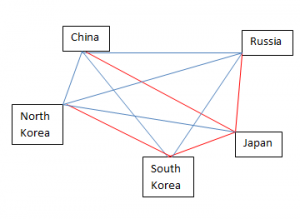Using Graph Theory to Analyze Recent Territory Disputes in East Asia
Recently, many cases of territory dispute erupted in East Asia involving China, Russian, Japan, Taiwan, and Korea. These disputes involved islets located among the five countries: Kuril Islands (known as Northern territory in Japanese) between Japan and Russia; Dokdo Islets (known as Takeshima in Japanese) between Korean and Japan, Diaoyudao Islands (known as Senkaku Islands in Japanese, Diaoyutai Islands in Taiwanese) among China, Japan, and Taiwan. Recently, Japan claimed to have nationalized Senkaku Islands (known as Diaoyudao in Chinese and Diaoyutai Islands in Taiwanese), and this move prompted large scale demonstrations in both China, Hong Kong, and Taiwan. Similarly, large scale protests also erupted in Japan as a response. Similar demonstrations also occurred amid the other disputes as well. Many worried these could prompt East Asia into a full-blown war ; however, by using graph theory to model the relations among these countries, one could see the possibility of serious armed confrontation is still quite small.
One can model the relations among these nations using positive and negative links. If there’s territory disputes between two nations, then the link is negative, otherwise, it will be positive. Following this rule, one can develop a graph as the following:
Blue lines represent positive links, and red lines represent negative links (there are land disputes between the two nations). From this we could see this is not a balanced/stable graph. The reason being that the triangle involving North Korea, South Korea, and Japan is not balanced. Furthermore, it’s reasonable to assume that an unbalanced international relationship structure is very unlikely to lead to war. This is because these nations cannot be assigned to two opposing groups (only balanced/stable graph could achieve this), and having a strict bipolar structure is often one of the necessary steps towards full-blown war, as shown in WWI and WWII.
This also makes political sense: due to the land disputes between North and South Korea, South Korea is unlikely to go into war with Japan since doing so will give North Korea, who has no dispute with Japan over territory, a chance to attack a weaker South Korea. Therefore, North Korea can actually be thought as a safeguard towards this potential armed conflict. Had North Korea disputes with Japan instead of Korea, these nations could be separated into two opposing groups (Japan v.s. the rest), and the possibility of a war is greatly increased.
-awesome7749

